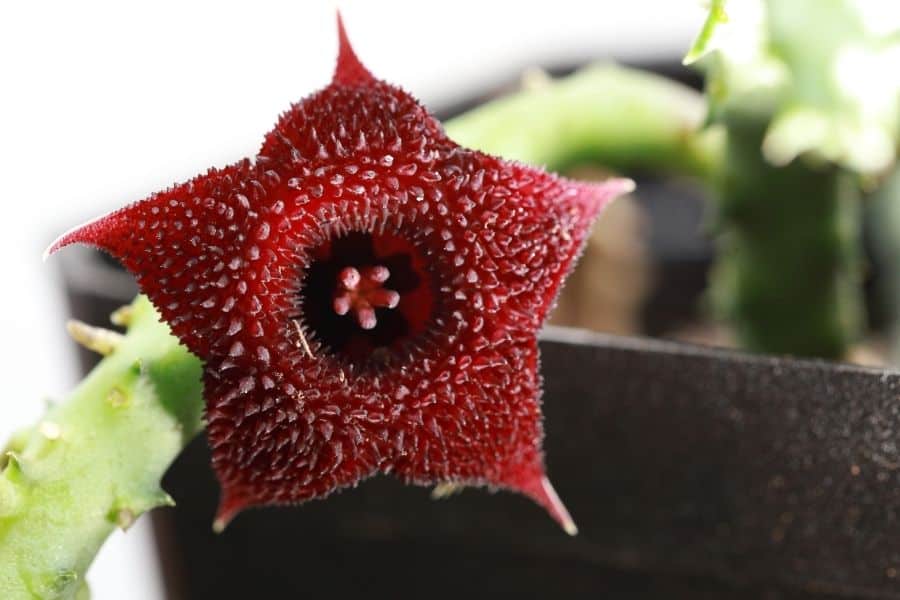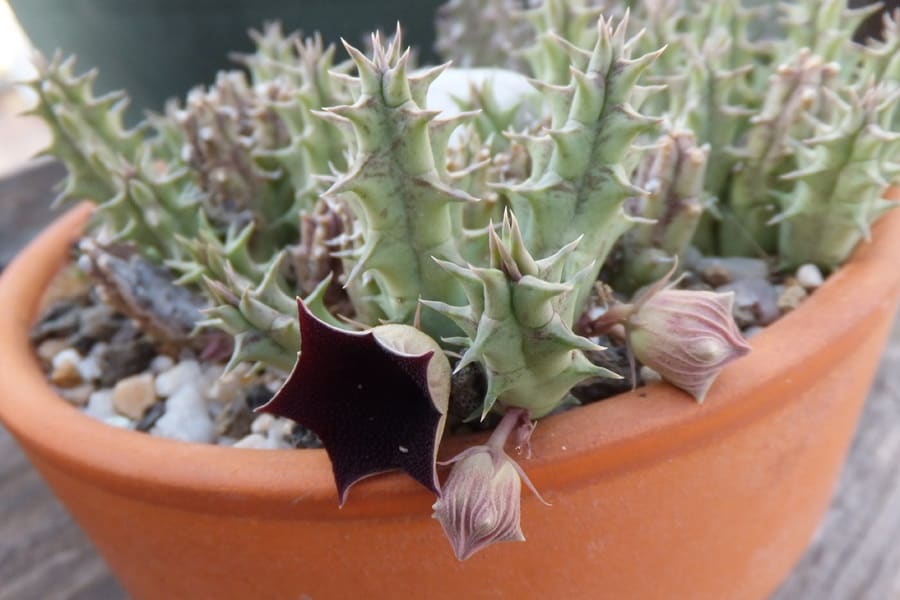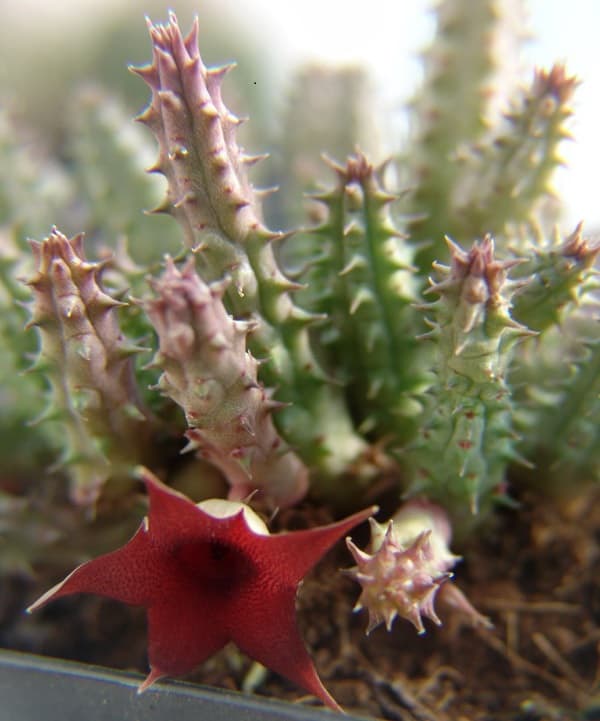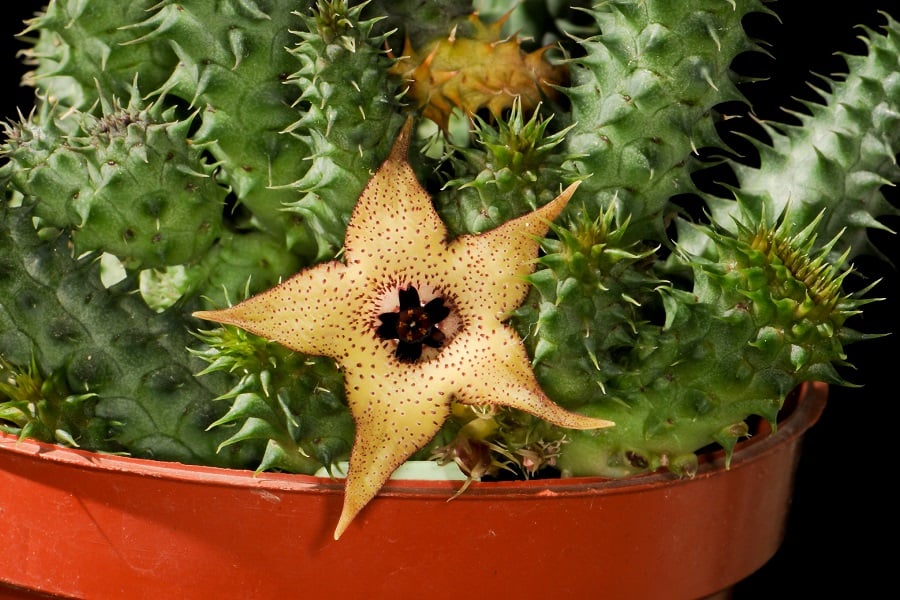Huernia macrocarpa 101: Care and Propagation Simplified
If you’re looking to add an exotic, eye-catching plant to your indoor garden, look no further than the Huernia macrocarpa. This unique succulent, native to areas like Ethiopia and Yemen, produces stunning star-shaped flowers that almost seem otherworldly. With colors ranging from light purple to deep red, these blooms are sure to be conversation starters. And despite their showy appearance, Huernia macrocarpa plants are surprisingly easy to care for at home. Keep reading to learn all about these living treasures.

Contents
About Huernia macrocarpa
The Huernia macrocarpa is a perennial succulent that forms clumps as it spreads via thick, branching stems up to 10 inches tall. These fleshy stems are green or grayish, cylindrical near the base, and become four or five-angled with coarse teeth along the ridges. From July to October, the plant produces bell-shaped, five-lobed flowers with curved petal tips jutting outwards or nodding downwards. A single stem can bear one or more of these exotic blooms simultaneously.

Related Post:
46 Types of Huernia With Pictures
Caring for an Huernia macrocarpa
Light
Huernia macrocarpa plants thrive in bright, indirect light. Too much direct sun can scorch the fleshy stems and leaves, leading to rot and other issues. An east or west-facing window is ideal. If your home doesn’t get enough natural light, supplement with a grow light positioned a few inches above the plant.
Watering
Proper watering is crucial for these succulents. In spring and summer when actively growing, allow the soil to dry out almost completely between waterings. Wait until the top 1-2 inches of soil is dry before giving the plant a thorough soaking. Drainage is very important – never let Huernia macrocarpa sit in water.
In winter when the plant is dormant, cut back on watering significantly. A light watering every 4-6 weeks is usually sufficient during this rest period. signs of overwatering include soft, shriveled stems and leaves or black spots.
Soil
A well-draining cactus or succulent soil mix is best for Huernia macrocarpa. Standard potting mixes tend to retain too much moisture. You can make your own fast-draining mix by combining one part potting soil with one part perlite or coarse sand. Terra cotta or unglazed ceramic pots are recommended as they allow excess moisture to evaporate through the sides.
Fertilizing
Feed your Starfish Flower every 4-6 weeks during the spring and summer growing season with a balanced liquid fertilizer diluted to half strength. Avoid fertilizing in winter when the plant is dormant and resting. Too much fertilizer can damage the roots.
Temperature
These succulents prefer average warm temperatures between 65-85°F during the day and a 10-15 degree drop at night. They can tolerate temperatures up to 100°F in summer if the soil is allowed to dry rapidly. Extended cold below 50°F should be avoided.
Pest and Diseases
Huernia macrocarpa is generally pest and disease free when provided with the right care. However, overwatering can lead to stem and root rot, often indicated by dark patches and soggy stems. Mealybugs or scale insects may also occasionally infest the plants. At the first sign of pests or rot, isolate the plant and treat with an insecticidal soap or neem oil spray. Remove any severely damaged stems.

Huernia macrocarpa Propagation
One of the best parts about growing these succulents is how easy they are to propagate from stem cuttings during spring and summer:
- Take a cutting from a mature, healthy Huernia.
- Allow the cut end to dry for a few days until calloused over.
- Plant the calloused cutting in fresh cactus potting mix.
- Lightly mist the soil to keep it slightly damp until new growth emerges in 2-4 weeks.
- Once rooted, care for your new plant just like the mother plant!
You can keep mature Huernia macrocarpa plants in the same pot for years as they don’t mind being pot-bound. For huge specimens, you may need to repot every 2-3 years into a container just one size up.
FAQs
Here are a couple of frequently asked questions on Huernia macrocarpa succulents that we have curated just for you. Read on!
How do you get Huernia macrocarpa to bloom?

There’s no special trick to getting these succulents to bloom – providing the proper care is key. Make sure your Huernia macrocarpa is in a well-draining container with a good potting mix formulated for cacti and succulents. Use a diluted, balanced liquid fertilizer every 4-6 weeks during the growing season. Most importantly, ensure the plant receives bright, indirect light and allow the soil to dry out between waterings. With these needs met, you’ll be rewarded with an abundance of exotic starfish-shaped flowers.
Is Huernia macrocarpa a cactus?
While it shares some similarities with cacti in terms of its succulent nature and care requirements, Huernia macrocarpa is not technically a true cactus. It is a type of stapeliad or carrion flower from the milkweed family. However, the fleshy stems, drought tolerance, and cultural needs of Huernia macrocarpa do closely resemble those of many cactus species.
Does Huernia macrocarpa need pruning or repotting?
These plants have minimal pruning needs aside from removing any dead or damaged stems. As for repotting, Huernia macrocarpa actually prefers to be pot-bound to some degree. You can leave established plants in the same container for 2-3 years before stepping up to a pot just one size larger. Frequent repotting into much larger containers is not recommended as it can lead to issues like rot from excess moisture.
